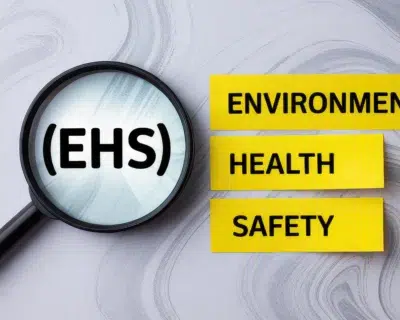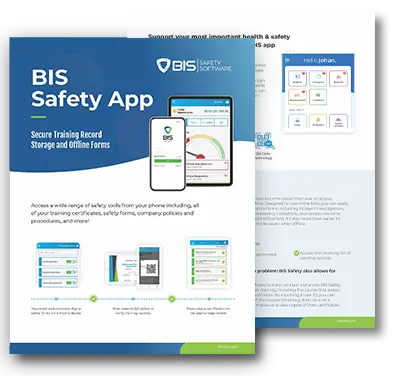
What is EHS Management – The Ultimate Guide
At its core, Environmental Health and Safety (EHS) management isn’t such a complicated topic. It’s about managing a collection of procedures, policies, and activities that are meant to keep workers safe, healthy, and productive. Once you start getting into the details, though, you quickly discover that there’s a lot more to learn. Below you’ll find everything you need to know about EHS management – and why it’s so important.
Explore this Article:
- What is EHS Management?
- The Three Pillars of EHS Management
- How is EHS Management Regulated?
- What is an EHS System?
- The Difference Between an EHS Management System and EHS Management Software
- What Happens if an Organization isn’t EHS Compliant?
- Key EHS Procedures that Every Organization Should Follow
- Advantages of an EHS Management System
- Everyone Benefits from an EHS Management System
What is EHS Management?
Environmental Health and Safety (EHS) is a blanketing term for safety, environmental, and well-being management. It’s the way a company reduces its production’s negative impact on its staff and surroundings. This could mean protocols, methods, training, safety, and anything to do with reducing negative impacts on the health of the workforce, and environment.
Although EHS management is required for organizations in many countries such as the US, Canada, and Great Britain, there’s no standardized set of policies or procedures that make up a single EHS management system. Yet there are similarities in all of them and more common ground than differences. Despite the commonality, each organization satisfies national or regional requirements before they address international. And generally, if companies are taking steps to ensure the well-being of their staff, they will be compliant with many of the requirements.
This includes details like having an incident management system in place; in the event of a workplace incident, there will be a protocol for responding to the incident, as well as reporting and recording it. With larger companies, it also includes choosing the rightEHS software, which can assist with incident reports, as well as employee training, hazard assessments, inspections, and much more. These are just a couple of examples; EHS management is a huge task, and it requires a slew of separate strategies, policies, and procedures.

The Three Pillars of EHS Management
Although each EHS management system is developed separately by every organization, they still have to follow the same goals and regulations. There are practically innumerable regulations to keep up with, but they all fall into one of three categories:
- Environment – Reducing an organization’s environmental impact.
- Health – Looking after the health of employees to prevent chronic disabilities, illnesses, injuries, or fatalities, while also maintaining productivity.
- Safety – Managing safety processes and work environments in order to prevent injuries, accidents, and incidents, and identify safety hazards.
How is EHS Management Regulated?
There are several regulatory bodies across the world that pass and enforce EHS-related legislation.
- Occupational Safety and Health Administration, or OSHA (in the US)
- ISO 45001:2018 (an international standard for EHS management systems)
- ISO 14001:2015 (an international standard for environmental management systems)
- Health and Safety Executive, or HSE (in Great Britain)
- European Framework Directive, or 1989/391/EEC (in the EU)
These are some of the main regulatory bodies, but many countries establish their own EHS regulations. OSHA for instance provides assistance and resources for any company trying to initiate or further develop its EHS strategy.
Regardless of which regulatory body an organization must answer to, they should count on a certain level of oversight. For example, many types of organizations are required to submit electronic records of illnesses or injuries. Other organizations may have to undergo a mandatory EHS audit as part of an enforcement action following a violation. Some companies even perform voluntary EHS audits, which can be helpful to uncover compliance issues in their EHS management system.

What is an EHS System?
This will depend on the organization – where it’s located, what industry it’s in, and how dedicated the company is to safety. Some EHS systems are robust and constantly updated, while others only accomplish the bare minimum. That being said, every EHS management system will have the following components:
- Regulatory compliance – Having an EHS management system in place is great, but an organization also has to prove that it’s in compliance by reporting on required data, as well as through audits and inspections.
- Document control – A reporting system is only as good as its document control, so this is an important aspect of an EHS system. Document control and management should improve visibility for past data, which can help reduce future errors. It also serves to prevent mistakes and mix-ups among the various reports and forms, plus it manages access to sensitive files.
- Training management – Employee training is an essential part of an EHS system, and this is best done with a training management system. This ensures that each employee is properly educated and trained to stay safe on the job, as well as improving participation in the organization’s safety culture. It also helps workers stay on top of industry regulations, which are constantly evolving.
- Audit management – Many organizations operate across multiple jurisdictions and company locations, which complicates the tasks of performing and tracking audits. Even smaller businesses need some form of audit management, as they’re required to follow up on any compliance issues that the audits uncover. This ensures that the audits accomplish what they’re supposed to accomplish, rather than an organization simply going through the motions just to say they did it.
- Incident reporting – This is necessary in order to capture, track, investigate, and report on all incidents, even if they’re “just” near-misses. Workplace incidents could include illness or injury, hazardous spills, incidents involving vehicles or heavy machinery, or property damage.
The Difference Between an EHS Management System and EHS Management Software
Even though they’re similar in both name and purpose, an EHS system is not the same as EHS software. An EHS management system describes an organization’s comprehensive approach to environmental, health, and safety issues. It’s made up of company policies, procedures, actions taken by employees and managers, and yes – EHS management software.
So, what is EHS management software? It’s just part of the puzzle, but it’s often a very big part. Depending on how advanced it is, EHS software can track incidents, maintain records on audits and employee safety training, notify employees when they’re required to update certifications or training, and much more.
What Happens if an Organization Isn’t EHS Compliant?
If an organization isn’t motivated to comply with EHS regulations in order to reap the many benefits (more on that later), they should at least do it to avoid the costs of noncompliance. The actual consequences will vary depending on what the violation happened to be, but they’re never easy to address. They may include:
- Increased worker’s comp insurance
- Elevated employee turnover
- Damaged reputation among competitors or clients
- Criminal charges
- Slowed or halted production
- Fines
- Costs from consultant or attorney fees, plus employee hours spent correcting noncompliance issues

Key EHS Procedures that Every Organization Should Follow
The specific policies that are implemented in an EHS management system will be unique to each organization, but they all stem from the same strategies and processes.
- Continuing improvement – Workplace safety isn’t something that can be implemented and then left to run on autopilot. In order to ensure high safety standards, it should always be improved year after year.
- Risk management – An EHS management system doesn’t just prepare organizations to respond to incidents; it also prepares them to anticipate and prepare for incidents.
- Stakeholder participation – Even the best EHS system won’t do much good if employees or managers aren’t following it. On the flip side of the coin, one sign of a successful EHS system is when everyone is on board.
- Leadership – From managers to upper-level leadership, they should be the driving force behind an organization’s EHS system.
- Organizational structure and commitment – To ensure that the desired safety norms are achieved organically, the EHS system will have to be carefully planned and implemented.
- Implementation and operations – Once the resources and structures are ready to go, it’s time to put them into action. This includes figuring out how to seamlessly incorporate the new safety practices into daily workflows; workers should feel like they’re adjusting to improvements, not being asked to perform additional tasks.
- Strategic planning – Upper-level management should be heavily involved in strategic planning, since they’re the ones who formulate policies and regulations for the entire company.
- Performance evaluation – After the organization has had some time to adjust to the new EHS system, every level of the work cycle should be evaluated to confirm that it’s performing as expected. If not, this is an opportunity to discover where there could be room for improvement.
- Senior management review – This is when all EHS strategies, mechanisms, implementations, and resulting evaluations are reviewed by senior management. At the end of the review, they’ll provide feedback to the implementation team.
Advantages of an EHS Management System
So far, we’ve focused on all the rules and regulations. But what about the practical reasons why an organization should implement an EHS management system?
- Reduced cost of administration – Because an EHS management system standardizes documentation processes, as well as bringing structure to procedures and policies, there’s less time spent on EHS issues and other critical operations.
- More engaged and educated workers – An EHS system plays a major part in an organization’s safety culture. Not only does it involve regular safety training, but it also makes workers feel valued and heard, which encourages participation in general.
- Easier compliance with regulations – Just because an organization is required to comply with certain regulations doesn’t mean they’ll have a proper EHS system in place. If they do, however, they’ll have a much easier time complying with these regulations.
- Improved efficiency – When workers spend less time off due to injuries or illness, this reduces downtime and drives productivity.
- Prevention of workplace incidents – This has many positive implications for an organization. A safer workplace due to an EHS system means improved employee satisfaction, higher employee retention, fewer costs for training new employees, fewer workers’ comp claims, a reduced number of lawsuits…and the list goes on.
Everyone Benefits from an EHS Management System
EHS management is a complex topic. Not only does it require organizations to understand countless regulations, but it also requires them to formulate, implement, and monitor a comprehensive safety strategy that applies to every level of their operation cycle. Even so, there’s no doubt that the benefits of an EHS management system far outweigh the costs for everyone involved. Employees can enjoy a safer work environment in a place that prioritizes their wellbeing, and companies can benefit from a boost to their reputation, reduced operating expenses, etc. When you look at the big picture, it’s clear that EHS management is a demanding task – but one that’s well worth the effort.




































